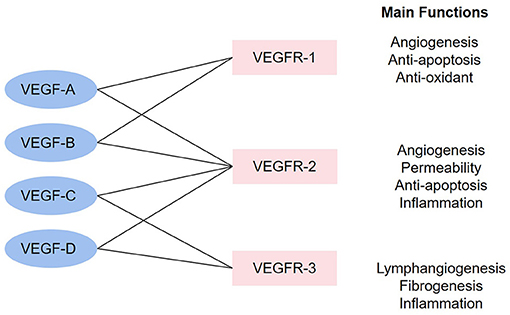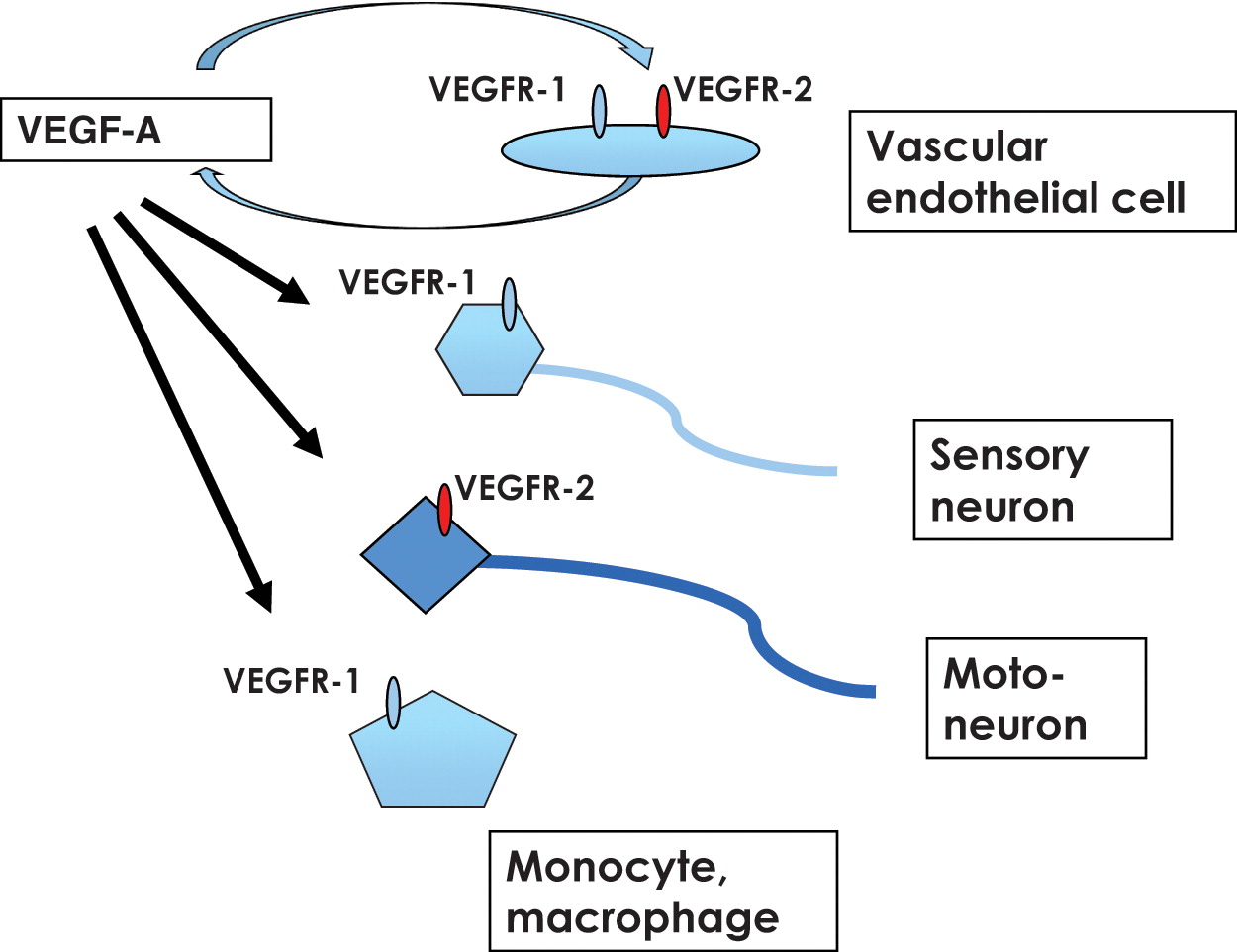Vascular Endothelial Growth Factor (VEGF) Family
Available Resources for The Study of VEGF Family
Creative BioMart is committed to supporting research on the VEGF family. We continually update our portfolio and resources to provide researchers with tools and information about the VEGF family (e.g., VEGF ligands and VEGF receptors).
- Our broad product portfolio includes recombinant proteins, etc., which play a key role in elucidating the functions and mechanisms of various players in the VEGF family.
- We have a team of experienced experts with deep knowledge in the study of the VEGF family, and we are committed to providing tailored solutions to meet the unique requirements of each researcher.
- In addition, we provide comprehensive resource support including involved pathways, protein function, interacting proteins, and other valuable information. Ultimately, our goal is to increase the impact of research efforts.
Our Featured Products
About VEGF Family
The VEGF (Vascular Endothelial Growth Factor) family consists of a group of growth factors and their corresponding receptors that play a critical role in angiogenesis, the process of forming new blood vessels from existing ones. The VEGF family is essential for the development and maintenance of blood vessels in various physiological and pathological conditions. Here's an introduction to the VEGF family, including VEGFs and their receptors:
VEGF Ligands
- VEGF-A: VEGF-A (or simply VEGF) is the most well-known and extensively studied member of the VEGF family. It exists in several isoforms generated by alternative splicing, including VEGF121, VEGF165, and VEGF189. VEGF-A predominantly acts on endothelial cells and promotes angiogenesis, endothelial cell proliferation, migration, and vascular permeability.
- VEGF-B: VEGF-B is structurally related to VEGF-A but has a distinct role in angiogenesis. It is involved in the regulation of blood vessel growth and maintenance in non-endothelial tissues, such as cardiac and skeletal muscle.
- VEGF-C and VEGF-D: VEGF-C and VEGF-D primarily regulate lymphangiogenesis (formation of lymphatic vessels) but can also influence blood vessel growth. They bind to VEGF receptor 3 (VEGFR-3) and promote lymphatic endothelial cell proliferation, migration, and survival.
- Placental Growth Factor (PlGF): PlGF is another member of the VEGF family that binds to VEGFR-1. It plays a role in pathological angiogenesis, particularly in ischemic diseases and cancer, by promoting endothelial cell proliferation and migration.
VEGF Receptors
VEGF receptors are receptor tyrosine kinases (RTKs) expressed on endothelial and other cell types involved in angiogenesis. VEGF receptors include:
- VEGFR-1 (Flt-1): Binds to VEGF-A, VEGF-B, and PlGF. It plays a role in vessel development, immune cell recruitment, and tumor angiogenesis.
- VEGFR-2 (Flk-1/KDR): The primary receptor mediating the effects of VEGF-A. It is primarily expressed on endothelial cells and is critical for endothelial cell proliferation, migration, and survival during angiogenesis.
- VEGFR-3 (Flt-4): Predominantly involved in lymphatic vessel development and lymphangiogenesis. It binds to VEGF-C and VEGF-D and plays a role in angiogenesis as well.
 Fig.1 The combinations in the VEGF family and main functions. (Zhou Y, et al., 2021)
Fig.1 The combinations in the VEGF family and main functions. (Zhou Y, et al., 2021)
The linkage between VEGF factors and VEGFR represents that the factors can combine with the receptors. The main functions stand for the functions after the activation of each receptor.
Functions and Signaling Pathways
- The VEGF ligands bind to their respective receptors, leading to receptor dimerization and activation of intracellular signaling pathways.
- Activated VEGF receptors initiate downstream signaling cascades, including the PI3K-Akt, Ras-MAPK, and PLCγ pathways, which regulate endothelial cell survival, proliferation, migration, and vascular permeability.
- VEGF receptor signaling also influences cell-cell adhesion, extracellular matrix remodeling, and the recruitment of inflammatory cells.
Therapeutic Implication
- The VEGF family and its receptors have significant therapeutic implications. Targeting VEGF ligands or receptors has been a major focus for developing anti-angiogenic therapies in diseases such as cancer, diabetic retinopathy, and age-related macular degeneration.
- Anti-VEGF therapies, including monoclonal antibodies and small molecule inhibitors, are used to block VEGF receptor signaling and inhibit pathological angiogenesis.
Understanding the VEGF family and its receptors is crucial for unraveling the mechanisms of angiogenesis and developing therapeutic strategies to target angiogenesis-related diseases. Further research on the VEGF family and its interactions with other signaling pathways will likely uncover new therapeutic opportunities in the future.
Importance of the VEGF Family in Disease
The VEGF (Vascular Endothelial Growth Factor) family plays a crucial role in various diseases due to its involvement in angiogenesis, the formation of new blood vessels. Dysregulation of angiogenesis can contribute to the pathogenesis of several diseases. Here's an overview of the importance of the VEGF family in different disease conditions:
Cancer
- Tumor angiogenesis: Solid tumors require a blood supply to grow and metastasize. VEGF-A, in particular, is upregulated in many cancers and promotes the formation of new blood vessels, facilitating tumor growth and metastasis. Targeting VEGF-A or its receptors has become a significant therapeutic strategy in cancer treatment.
Macular Degeneration and Retinopathy
- Age-related macular degeneration (AMD) and diabetic retinopathy are leading causes of vision loss. In these conditions, abnormal blood vessel growth in the retina leads to retinal damage. VEGF-A is a key player in the pathogenesis of these diseases. Anti-VEGF therapies, such as intravitreal injections of anti-VEGF antibodies, are now standard treatments for these conditions.
Cardiovascular Diseases
- Ischemic heart disease: In conditions such as coronary artery disease, reduced blood flow to the heart can cause ischemia. VEGF-A and other VEGF family members are involved in the body's response to ischemia, promoting angiogenesis and collateral vessel formation to improve blood supply to the heart muscle.
- Peripheral arterial disease: Reduced blood flow to the limbs in peripheral arterial disease can lead to tissue damage and impaired wound healing. Therapies targeting VEGF and VEGF receptors are being investigated to stimulate angiogenesis and improve blood flow in these conditions.
Inflammatory Diseases
- Rheumatoid arthritis: Inflammation in rheumatoid arthritis leads to the proliferation of blood vessels in the synovial tissue of the joints. VEGF-A plays a role in this angiogenic process, contributing to joint inflammation and destruction. Targeting VEGF-A has shown potential in managing rheumatoid arthritis.
- Inflammatory bowel disease (IBD): Inflammation in IBD, including Crohn's disease and ulcerative colitis, is associated with increased angiogenesis. VEGF-A and VEGF receptors are upregulated in the inflamed intestinal mucosa, contributing to pathological blood vessel growth and disease progression.
Other Diseases
- Pulmonary hypertension: Disturbed angiogenesis and vascular remodeling in the lungs contribute to pulmonary hypertension. VEGF receptors, particularly VEGFR-2, are involved in pulmonary vascular development and remodeling.
- Endometriosis: Endometriosis is characterized by the growth of endometrial-like tissue outside the uterus. VEGF-A promotes angiogenesis within endometriotic lesions, contributing to their growth and survival.
Understanding the role of the VEGF family in these diseases has led to the development of targeted therapies aimed at inhibiting VEGF or its receptors. Anti-VEGF therapies, such as monoclonal antibodies and small molecule inhibitors, have been successful in managing various diseases characterized by aberrant angiogenesis. However, the complexity of angiogenesis and the involvement of multiple signaling pathways necessitate ongoing research to further elucidate the mechanisms and identify new therapeutic targets.
 Fig.2 A pro-angiogenic therapy using the VEGF-VEGFR system. (Shibuya M, et al., 2011)
Fig.2 A pro-angiogenic therapy using the VEGF-VEGFR system. (Shibuya M, et al., 2011)
Recent studies suggest that sensory neurons express VEGFR-1 and motoneurons express VEGFR-2. These receptors are biologically functional, and therefore, an appropriate ligand, such as VEGF-E, can be used for pro-angiogenic therapy as well as for neuron protection therapy.
We are committed to helping you achieve your scientific goals and make meaningful contributions to research on the roles of the various components of the vascular endothelial growth factor (VEGF) family and their role in disease. Contact us today to learn more about our products and resources.
References:
- Zhou Y, Zhu X, Cui H, et al. The role of the VEGF family in coronary heart disease[J]. Frontiers in cardiovascular medicine, 2021, 8: 738325.
- Shibuya M. Vascular Endothelial Growth Factor (VEGF) and Its Receptor (VEGFR) Signaling in Angiogenesis: A Crucial Target for Anti- and Pro-Angiogenic Therapies. Genes & Cancer. 2011;2(12):1097-1105.


